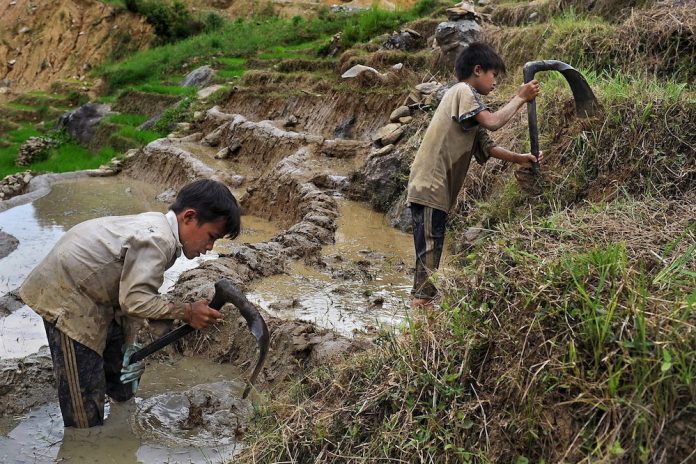This article is written by Shruthi Nair, pursuing a Diploma in Labour, Employment and Industrial Laws (including POSH) for HR Managers from LawSikho.
Table of Contents
Introduction
Child labour is a very normal sight. Supply networks are plagued with it. There are a few, doing everything they can to eliminate child labour from their supply chains, while there are others who are oblivious to the situation or unwilling to acknowledge it. When we address the issue of child labour, we don’t refer to the children engaging in household chores, part-time jobs or lending a hand to propagate family business. The Child Labour Act of 1986 mentions the various ways in which children are exploited. Such as-
• Prostitution,
• Slavery,
• Illegal drugs,
• Pornography.
India’s Census 2001 office defines child labour as participation of a child less than 17 years of age in any economically productive activity with or without compensation, wages or profit. Such participation could be physical or mental or both. Amongst all the chaos about protecting children there are a few voices seeking to explain the use of child labour in supply chains, are there actual conditions in which it might be justified? This is a question that both corporations and individuals should evaluate.
Justifications/excuses and myth busting
- A family could not subsist without child labour. Children can supplement a family’s income by assisting in the family business or working outside the home. To sum this up in one word, it would be “poverty”
Child labour may appear to be a quick fix for financial problems, but it is actually a source of poverty. Children are unable to receive an education as a result of child labour and extended hours put into work to be able to contribute to the sustenance of the family. Without education, the next generation of children will grow up uneducated and unable to break the cycle of poverty.
- Child labour benefits small firms in third world nations because it allows them to pay lower wages. Families benefit as well since they obtain some sort of financing than none at all.
Adult unemployment is caused via child labour. Children are paid significantly less and compelled to work longer hours, making them a far more appealing offer for corporations looking to save money. Adult workers are subsequently left without a source of money, perpetuating the cycle of poverty that forces children back into the workforce.
- Young girls are less likely to be educated resulting from cultural beliefs, especially if they also have male siblings. For young girls, child labour provides some type of income and/or job
Child labour encourages gender prejudice and prevents females from receiving the benefits of an education. Girls have a higher and almost sure chance of being used in the sex industry and as a result, prefer to choose to stay at home and receive little or no education.
- Children are required to perform important tasks that demand their small physique for precise and intricate work or their small frames in limited locations like mines.
Child labour compels youngsters to do dangerous jobs that should only be undertaken by qualified and trained adults in environments with adequate health and safety procedures.
India attempted to make the use of children in the labour force forbidden. The days of children having faces covered in sawdust and soot from the mines to earn a living and help their impoverished families have a foreseeable end. The justifications described above are the same ones used by individuals in this country who believed child labour was an essential practice, particularly for the poorest Indian households. Children’s use grew undesirable throughout time, and the education of children became a tool to assist families to escape poverty. We may have prohibited child labour as a country, but we are still involved in the usage of children. The only difference between now and the 1800s is that today’s children do not work in our factories or up to our chimneys but are used in much more intense jobs that are risky for even grown skilled labourers.
Why are we so compliant in still exploiting children among states if we find child labour so repulsive in this country? Are we choosing to turn a blind eye and disregard the problem at hand? We must not fall into the trap of believing that child labour can be justified in some way. Because poverty lies at the foundation of child labour, shouldn’t the solution be to target the source of the problem? Child labour may alleviate some of a family’s poverty, but it is not a long-term solution. Instead of unearthing and exposing child labour for the heinous practice that it is, all this accomplishes is to put a false gloss on it.
The solution is not simple, quick, or inexpensive, but it is feasible. Those who wish to see change have an uphill battle, but the suggestion is to persevere.
Just recognizing and acknowledging the issue that prevails in our country isn’t enough. Active steps should be taken towards the complete eradication of child labour.
What can be done?
Taking responsibility
Who is responsible for assisting in the abolition of child labour? Everyone is the answer. We can’t expect children’s lives to change unless we acknowledge that everyone has a responsibility to do something. Whether you’re a business owner or a customer, your decisions have an impact on child labour.
A collaborative approach
While some of the activities required to stop child labour are costly and time-consuming, a collaborative approach can help spread the burden. Child labour can be eliminated if a business and a local government agree on initiatives such as providing groceries to a family to compensate for a child’s lost income as a result of receiving an education instead of working.
Children belong in the school
If a company is functioning inside a region and receiving the benefits, they must ask themselves, “Is there enough schooling for all children?” If the response is no, this should serve as a red flag to companies. What are the children doing on a daily basis if there are no schools? It’s likely that they’ll be used in the local labour market. Businesses can collaborate with others to implement schooling as part of a collaborative strategy.
Transparency in the supply chain
Businesses should be familiar with their supply chains and the complexities that surround them. It is critical to map supply networks and gain a thorough understanding of the layers that make up a supply chain.
Being informed
Businesses must educate themselves so that they can not only recognize but also respond to child labour. How do you know you don’t have child labour if you don’t know what you’re searching for? Child labour is a secret element of the supply chain, and understanding how to spot it can not only protect businesses but also help put a stop to it.
The government of India passed the Child Labour (Prohibition and Regulation) Act in 1986, fully acknowledging the significance of child labour as a long-standing issue. This Act has been included in various other acts dealing to persons in the labour force, such as “The Factories Act 1948″ and “The Mines Act 1952.”
Although acknowledgement of the issue of child exploitation at hand is a humongous step toward the eradication of the current plight of the unfortunate children, it is only the very first step. The establishment of the CLPR Act must be followed up by active measures to completely incorporate it into the system.
To counteract the pervasiveness of child labour, the Indian government has enacted a slew of actions, regulations, organisations, and institutions. The functioning of such capillary organisations and the will of each citizen in our country toward the eradication of darkness in the lives of the children in our country will help us with the elimination of child labour from the functioning of this country.
Conclusion
Although the Child Labour Prohibition and Regulation Act provides for the conditions under which there are “prohibitions of employment of children in certain areas” and several other provisions incorporated into the act take into consideration the physical safety of the children, it completely neglects the element of mental health of the children that will eventually help them shape the future and sustenance of the future of the system in our country.
The literacy rate in India in the years 2017-18 showed to be 77.7%, which is not all that great a percentage. A sound mind alongside education and awareness of the current situation can and only will help the children to look and think forward so as to get out of the never-ending cycle of poverty and circumstances that promote the dependency of incomes from minors of the family.
“Progress is impossible without change, and those who cannot change their minds cannot change anything.”
We as decent human beings must progress towards a society where child labour and conditional child labour was a thing of the past; toward a society where the education of children is of top priority and toward a society where the literacy rate has taken a leap.
Students of Lawsikho courses regularly produce writing assignments and work on practical exercises as a part of their coursework and develop themselves in real-life practical skills.
LawSikho has created a telegram group for exchanging legal knowledge, referrals, and various opportunities. You can click on this link and join:
https://t.me/joinchat/L9vr7LmS9pJjYTQ9
Follow us on Instagram and subscribe to our YouTube channel for more amazing legal content.
 Serato DJ Crack 2025Serato DJ PRO Crack
Serato DJ Crack 2025Serato DJ PRO Crack











 Allow notifications
Allow notifications



